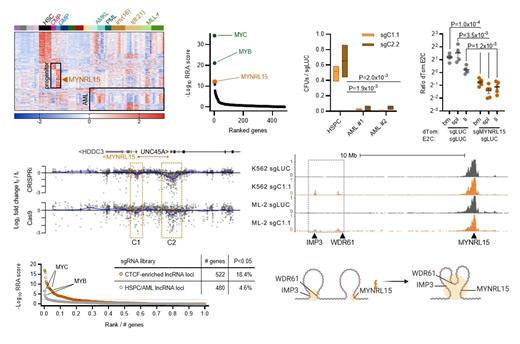Abstract
The noncoding genome presents a largely untapped source of biological insights, including tens of thousands of long noncoding RNA (lncRNA) loci. While some produce bona fide lncRNAs, others exert transcript-independent cis-regulatory effects, and the lack of predictive features renders their mechanistic dissection highly challenging. Here, we describe CTCF-enriched lncRNA loci (C-LNC) as a putative new subclass of functional genetic elements exemplified by MYNRL15 - myeloid leukemia noncoding regulatory locus on chromosome 15.
Initially identified by an expression-guided CRISPRi screen of hematopoietic stem and progenitor (HSPC) / acute myeloid leukemia (AML) lncRNA signatures (480 genes, 1545 sgRNAs), we found MYNRL15 dependency in myeloid leukemia cells of diverse genetic backgrounds. Interestingly, cis and trans perturbation approaches revealed both the MYNRL15 transcript and its flanking protein-coding genes to be dispensable. High density CRISPR tiling of a 15 kb area centered on MYNRL15 (1613 sgRNAs) instead uncovered two crucial, candidate cis-regulatory DNA elements in the locus, which drive the MYNRL15 perturbation phenotype. To determine the molecular basis of MYNRL15 dependence, we performed transcriptome, chromatin conformation, chromatin accessibility, and CTCF profiling. RNA-sequencing established MYNRL15's involvement in maintaining key cancer dependency pathways (e.g. cell cycle, ribosome, spliceosome). Further, MYNRL15 perturbation associated with the coordinated dysregulation of several chromosome 15 neighbourhoods, and formation of a long-range chromatin interaction between the locus and the base of a distal loop, as detected via next-generation Capture-C. The gained interaction was accompanied by diffuse gains in chromatin accessibility across the distal interaction sites (ATAC-seq) as well as reduced CTCF occupancy at the MYRNL15 locus (CTCF CUT&RUN), altogether indicating the 3D re-organization of chromosome 15 following MYNRL15 perturbation. Integrative analysis of the chromatin conformation and transcriptome data, combined with a small CRISPR-Cas9 knockout screen of protein-coding genes from the gained interaction region (29 genes, 149 sgRNAs), pinpointed two potent cancer dependency genes that are located in the region and downregulated following MYNRL15 perturbation: namely, WDR61 and IMP3. Individual knockout of both genes robustly depleted myeloid leukemia cells, recapitulating the MYNRL15 perturbation phenotype and positioning WDR61 and IMP3 as its regulatory targets. Importantly, in primary cells, MYNRL15 perturbation eradicated AML blasts while sparing 50-60% of CD34 + HSPCs in vitro, and reduced patient-derived AML xenografts up to 10-fold in vivo, indicating a potential therapeutic window.
Having implicated MYNRL15 in 3D genome organization and demonstrated its role in myeloid leukemia cells, we explored whether MYNRL15 may belong to a sub-category of biologically relevant lncRNA loci that have thus far been overlooked due to their lack of transcript-specific functions. Remarkably, elevated CTCF density (e.g. number of CTCF binding sites per kb of gene length) distinguishes MYNRL15 and 531 other lncRNA loci in K562 cells, of which 43-54% associate with genetic subgroups and/or survival in AML patient cohorts, and 18.4% are functionally required for leukemia maintenance as determined by CRISPR-Cas9 screening. The latter hit identification rate represents a substantial improvement over typical lncRNA essentiality screens (which range from 2-6%) - illustrating the effectiveness of CTCF density metrics in refining functional lncRNA candidate lists, and underlining the relevance such loci hold for AML and cancer pathophysiology in general. Curated C-LNC catalogs in other cell types will facilitate the search for noncoding oncogenic vulnerabilities in AML and other malignancies.
Reinhardt: Celgene Corporation: Consultancy; Novartis: Consultancy; Bluebird Bio: Consultancy; Janssen: Consultancy; CLS Behring: Research Funding; Roche: Research Funding. Klusmann: Bluebird Bio: Consultancy; Novartis: Consultancy; Roche: Consultancy; Jazz Pharmaceuticals: Consultancy.


This feature is available to Subscribers Only
Sign In or Create an Account Close Modal